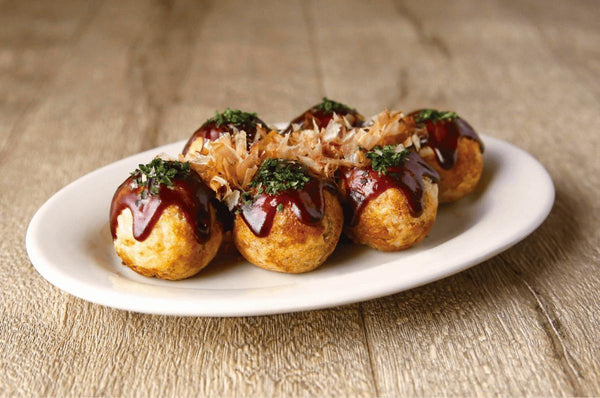
Jump to:
What are Takoyaki Balls?
Takoyaki is a popular and delicious Japanese street-food that originated in Japan’s Osaka region. Traditional takoyaki is essentially a ball-shaped dumpling filled with small pieces of tender octopus, but nowadays you can also make takoyaki using a variety of fillings to better suit your dietary requirements and tastes.
The main filling and other ingredients like green onion are cooked inside a flour-batter and topped with a Worcestershire-style sauce, Japanese mayo, and dried bonito flakes to finish.
Takoyaki can be found throughout Japan at convenience stores, food stands, and specialty takoyaki shops. It’s also a fun dish to make at home with friends and family and is easy to customize using your favorite fillings from cheese to kimchi! Read on to learn more about this Japanese soul food and how to make it at home in our recipe post.

A Brief History of Takoyaki in Japan
Takoyaki first appeared in Japan around 1935 when an Osaka street-food vendor called Tomekichi Endo was inspired by a similar softer and eggier recipe called akashiyaki to come up with the idea to create crispy takoyaki dumplings.
During the 1950s the dish evolved to include sauces on top of the dumplings, and by the 1960s and 1970s, takoyaki shops had begun to crop up throughout Japan. Today one of Japan’s most popular chain of takoyaki shops is Tsukiji Gindako, founded in Gunma Prefecture in 1997, whose dumplings are known for their extra crispy outer layer.
What Does Takoyaki Taste Like?
The key ingredient, diced octopus, adds a tender, slightly chewy texture and a mild seafood flavor. Takoyaki is typically seasoned with soy sauce, dashi (a Japanese broth), and other flavorings, giving it a rich umami taste. It's often topped with takoyaki sauce (similar to Worcestershire sauce), bonito flakes (dried fish flakes), aonori (dried seaweed), and mayonnaise, which add layers of sweetness, saltiness, and creaminess, creating a savory and satisfying snack or meal.
When is the Best Time to Eat Takoyaki?
Takoyaki is a popular street-food and can often be found at festivals, particularly during the summertime. When purchased at a store, takoyaki is usually sold in packs containing 6 to 15 pieces in total, making it an ideal fast-food for lunch or evening snack. If you eat takoyaki at home, you can increase the quantity of dumplings to make enough for a meal for the whole family.
In addition to the octopus pieces, the dumplings can also contain other ingredients such as cheese and sausage, and other sauces such as ponzu and soy sauce can be used as condiments to add a variety of flavors and tastes. Takoyaki parties are also a popular event to invite family and friends to enjoy.
Takoyaki Cooking Tools and Utensils
Before you try making takoyaki at home, there are a few essential tools you’ll need to get started.
Takoyaki Grill Pan

A takoyaki machine is a special pan with multiple hemispherical holes to give the dumplings their round shape. There are two types: an electric takoyaki pan that is connected to an electric cord, and one that is simply used on a gas stove.
There are usually around 15 to 25 spherical molds on one grill pan, and even if you live outside of Japan, you can find easily find them available to purchase online. In Japan, it is said that every family in the Kansai region owns a takoyaki grill!
Oil Brush

When preparing the takoyaki, you need to spread oil evenly to all corners of the takoyaki machine’s surface. For this you’ll require a brush that can easily soak up and spread the oil. This LEC oil spreader brush is the perfect utensil for the job.
Takoyaki Pick

We use picks to easily separate the batter and flip the takoyaki balls directly on the frying pan. There are silicon and metal versions available which can be purchased at any hundred-yen store in Japan.
If your takoyaki machine is Teflon coated, be careful not to use a metal pick as it will peel off the Teflon. Bamboo skewers or chopsticks can be used as substitutes, or you can use these purpose built takoyaki picks by Shimomura.
Other kitchen utensils you’ll need to make takoyaki include a bowl, mixer, and measuring cup.
Takoyaki Ingredients
Takoyaki Flour

This special flour mix is available at any Japanese supermarket. It is ideal for making delicious takoyaki because it includes the flour and necessary seasonings such as soup stock and salt, and emulsifiers to make the baked product crispy on the outside and thick on the inside.
Various manufacturers offer these mixes, but approximately one bag of 500g will make 100 takoyaki dumplings. If you don’t live near a Japanese supermarket, then you can also order the flour mix online via the Japanese Taste store.
Nisshin Takoyaki flour mix contains powdered dashi (bonito and konbu seaweed extract) and pickled ginger to give the takoyaki an extra umami kick, and Nippon Japanese Takoyaki Flour Mix also contains powdered dashi and contains enough flour to make approximately 40 takoyaki balls.
Takoyaki Filling
Traditional takoyaki contains octopus, and while there are many different types of octopus sold in Japanese supermarkets, the octopus best suited for takoyaki is the "madako(真だこ)," which has a tighter body and a firmer texture. A good octopus is pink in color and has suckers of uniform size.
We also have a takoyaki recipe on our site which you can access here. If you're not a fan of octopus or wish to substitute it with other ingredients. We have 10 suggestions of alternative fillings in our recipe post.
Green Onions
Chopped spring onions are very tasty either in the takoyaki dumplings or on top of the grilled takoyaki as a topping.
Beni Shoga (Red Pickled Ginger)

Chopped red ginger is mixed inside the takoyaki to accentuate the flavor. Red pickled ginger is a popular Japanese ingredient that has been used in cooking since ancient times and is loaded with antioxidants and nutrients.
Tenkasu

Tenkasu are crunchy bits of fried batter left after cooking tempura and have several advantages when used in cooking takoyaki. The flavor becomes richer, and the oil from the tenkasu oozes out to make the takoyaki become crispy. The oil from the tenkasu also makes it easier to peel off the dough from the plate.
Takoyaki Sauce

This sweet and spicy sauce is essential for takoyaki seasoning at the end. Takoyaki sauce is a dark and rich salty Worcestershire-type sauce made from soy sauce, vegetables, fruits, and spices. One of the leading Takoyaki sauces is made by food manufacturer Otafuku, whose sauce can be added directly on the takoyaki. This smooth and glossy Takoyaki sauce had been thickened so it doesn’t drip!
Japanese Mayonnaise
The spicy flavor of the sauce alone is mellowed by the addition of Japanese mayo and is complemented by the thick batter of the takoyaki. Unlike American mayonnaise, Japanese mayo is made only using the egg yolk instead of the entire egg and is slightly more yellow in color.
A different kind of vinegar is also used to make the mayonnaise, with Japanese mayo using rice vinegar instead of distilled vinegar. These differences in ingredients help to create a creamier and sweeter Japanese mayo compared to its Western counterparts.
Katsuobushi (Dried Bonito Shavings)

These are sprinkled as a final topping, to create a rich and appetising aroma. Adding katsuobushi to your takoyaki will make them authentically Japanese in an instant. Katsuobushi are sometimes known as ‘dancing flakes’ due to the way they move when placed as a topping on hot dishes.
Aonori (Dried Green Seaweed)
Aonori is a versatile type of edible seaweed found mainly off the coast of Japan, and usually sold in dried or powdered form. It is used primarily as a topping or garnish, adding color and flavor to popular dishes like takoyaki.
What to Serve with Takoyaki
Takoyaki is often served in combination with okonomiyaki and yakisoba. Okonomiyaki is made by putting cabbage in the batter and adding pork or seafood and cooking it like a pancake. Yakisoba is made by stir-frying cabbage, carrots, and pork with noodles.
Although they look different, the main ingredient of takoyaki, okonomiyaki, and yakisoba is wheat flour, and all these dishes have similar seasonings and sauces too. In the Kansai region, these dishes are known as Konamon, which is taken from the word Kona (flour powder).
Why did konamon become a local food in Kansai? There are various theories, but one theory is that the quick, inexpensive, and tasty characteristics of flour dishes suited the impatient nature of Kansai people.
Since the Meiji era (1868-1912), many popular sauce companies have been founded around Osaka, and this is also one of the reasons why these dishes have become so rooted in the Kansai region.


0 comments